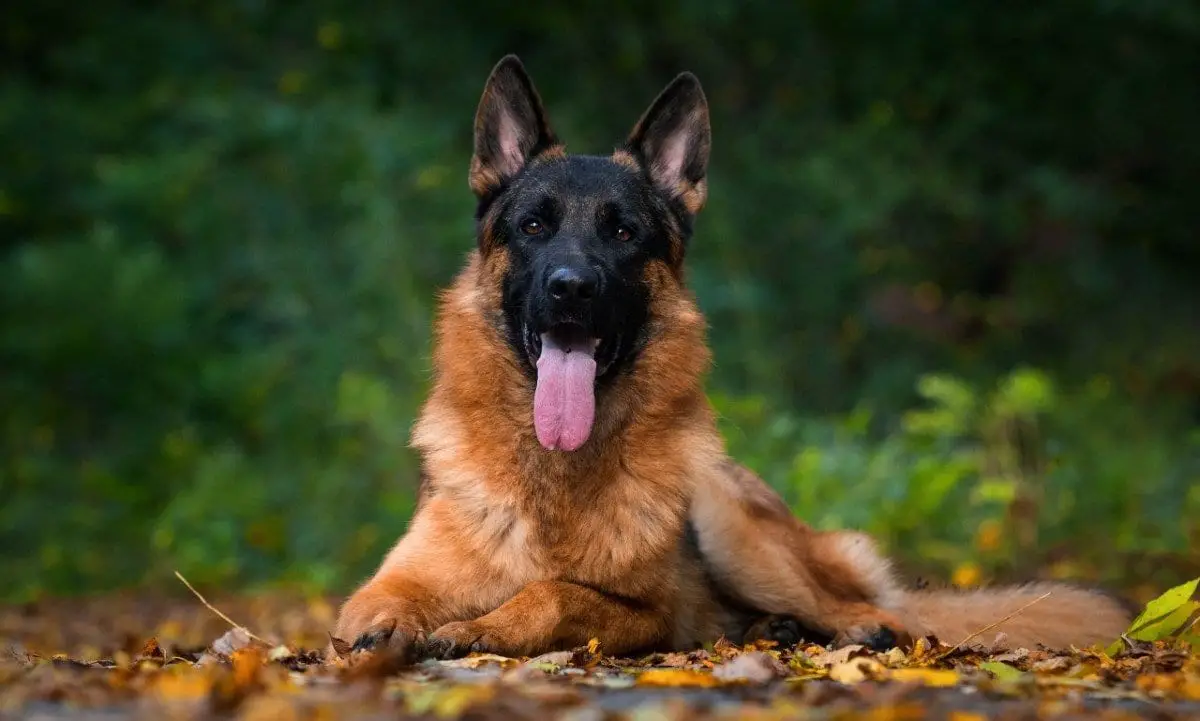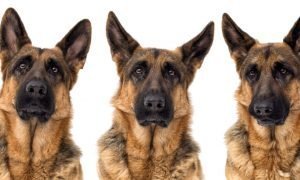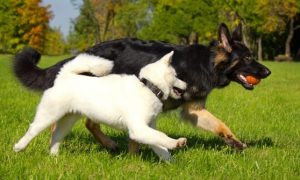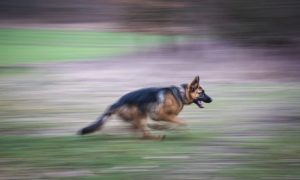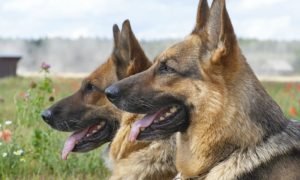Known for its obedient, loyal, protective, and intelligent attributes, the German Shepherd Dog is a hard-working, loving companion.
The German Shepherd is an exceptional canine from their unmistakable stack to their most popular black and tan coat coloration.
However, while their standard color has become synonymous with the breed, did you know there are 13 coat variations?
That’s right, less popular coat color variations include everything from black, blue, red to white and everything in between.
A Dog Breed of Many Colors
While the German Shepherd dog has a wide assortment of color combinations, their overall coat has no bearing on temperament, behavior, or inherent health conditions.
One can still expect similar traits from an uncommonly colored German Shepherd, as you can from a classic black and tan.
Coat colors do, however, provide a glimmer into your puppy’s history. Let’s take a look at each of the 13 color combinations German Shepherds have to offer.
1. The Classic Black and Tan
When you think of a German Shepherd, the black and tan coat is the most common of all combinations.
And, while it may be the most iconic fur pattern of the German Shepherd dog, it’s a recessive gene. That’s right, the classic saddle pattern and black face mask are recessive and utterly dependent upon gene inheritance from the parents.
The tan in this coloration may vary in color, from a range of light to dark tints – even with puppies from the same litter. A puppy’s fur color may also lighten as they grow out of their adolescent fur through maturation.
2. A Black and Cream Variation
This coat coloration appears much like the black and tan, with a slight variation in the tan areas.
Rather than being as dark as the classic coat, a black and cream German Shepherd’s cream fur is much lighter and brighter shade than that with tan.
This coat still carries the stereotypical saddle pattern on their back, with the typical black mask on their face. The best part of a black and cream is the stark contrast between the bright cream fur and dark black markings.
3. Showy Black and Red GSD
Well-suited to show bloodlines, the black and red coloration also looks much like a black and tan German Shepherd.
A red pigmentation replaces the tan area, featuring a much stronger color saturation in a reddish-brown shade. Sometimes the red may vary in hue, from strawberry blonde to a rich copper, in light or dark variations.
With this color, although it isn’t as common as the others, the puppies typically carry the iconic saddle pattern and black mask, as well.
4. As Precious as Silver
Now we will get into less common fur color combinations of the German Shepherd dog.
There aren’t as many other colors comparable to that of the silver-coated GSD. Their rareness is believed to be caused by recessive genes; however, they originate from working bloodlines.
Shepherds of this coat color are also less prevalent in the show ring, simply because of their lighter appearance.
This coat variation also carries the classic saddle pattern along their back, as well as the black mask on their face and nose. The stark difference is that of the silver coloration in place of tan.
5. The Rare Liver Variation
Perhaps one of the rarest color variations of the German Shepherd Dog is that of the liver coat. Although liver is commonly found among other dog breeds, it’s a recessive gene in both German Shepherd bloodlines (working and show).
Thus, both parents must carry the liver color traits for the genes to be passed along to resulting puppies.
Although this style of German Shepherd dog is rare and uncommon, they still present saddle and mask style areas of saturation.
This coat does not display any areas of black, but rather darker areas of liver instead. Some pups, however, may not even display a liver-colored saddle or mask at all.
6. Gorgeous in Steel Blue
German Shepherd dogs with the steel blue color variation appear to be in a league of their own.
With a satin blue-based gray appearance, steel blue GSDs look more like a wolf, with bright amber eyes, than more common colored German Shepherds.
The lack of a mask or saddle pattern attributes even further to their wolf-like appearance. Featuring a blue pigmentation, this coat is seen as a fashion choice, and puppies aren’t bred for either show or working lines.
And while this coat coloration is considered extremely rare for a GSD, it is categorized as a serious fault, unable to compete in show competitions.
The American Kennel Club, however, still recognizes it as an official color variation. Parents must also both carry this gene for it to be passed along.
7. Historically Rich Sable Coat
The very first German Shepherd dog born in 1895, Horand von Grafrath, had a sable coat variation. Thanks to the “agouti” dominant gene, this coloration is an important aspect of all German Shepherds’ genetics.
Although the sable coat isn’t as popular as the aforementioned saddle variations, it provides a historically rich coat.
Because people tend to lean toward black and tan coated puppies, breeders have invested their time in breeding these lines rather than sable coats.
The interesting aspect of the sable coat, however, is the ombre effect provided by a mixture of light and dark pigmented hairs. This coat’s hairs are not a solid color, and single hairs often give a combination of coloration within individual strands.
8. Shades of Gray
It’s interesting to see the wide variations of gray available in German Shepherd coat colors.
Unfortunately, while the gray coated GSD is often confused with blue and silver colorations, the gray German Shepherd dog is a distinct color individually recognized by the AKC.
One specifically unique aspect of the gray GSD is that they are born with spectacular blue eyes. While a gray German Shepherd puppy grows to adulthood, their blue eyes change to a light brown, honey, or amber color.
Much like the sable coat, the gray color is produced by a dominant gene that must be present in both the sire and dam bloodlines to pass along.
9. Red Sable Color Variation
Yet another coat coloration due to the agouti gene, red sable German Shepherds present a deep reddish-brown hue, replacing the tan pattern presented by sable coated dogs.
Thanks to a similar multicolored hair strand, the fur of a GSD is intermingled with black and red ombre across the majority of the dog’s body.
10. Bi-Colored GSD
Ratios play a significant part in the overall appearance of this specific German Shepherd coloration. Although bi-colored coated German Shepherds present black and tan fur, they have up to a 9:1 black to tan ratio than standard black and tan German Shepherds.
More often than not, the bi-color GSD is mistaken as a pure black Shepherd due to black dominance throughout the coat.
A German Shepherd is considered a bi-color if any other color shows through the black coat, regardless of how small of an amount it may be.
11. Black and White Panda
German Shepherds of the Panda coloration may be mistaken as another dog breed altogether, or a mixture of breeds.
This genetic mutation is considered quite rare and has been carried through a single bloodline. The mother features pure black fur, while the father displayed standard black and tan.
Up to 40% of a panda German Shepherd’s body is white. However, there haven’t been any white German Shepherds throughout their ancestry.
This appearance is simply due to a genetic anomaly, which causes white spotting. This purebred German Shepherd Dog closely resembles a panda’s coloration and is sure to catch the eye of many.
12. Pure White
Considered to be an extraordinary coat coloration, white GSDs are all but albino. While people tend to believe a white Shepherd is an albino, the white German Shepherd is not due to this genetic disease.
A white-coated German Shepherd is all thanks to genetics, another recessive trait. Because this coat variation was considered a weak characteristic, it has not been continued through working lines.
Unfortunately, the AKC does not recognize this color and disqualifies white German Shepherds in competition.
Both parents must carry the white genes in order to produce healthy, white puppies. More often than not, breeders will utilize a white sire and white dam to generate the desired result.
13. All Black
Finally, we come to the final coat variation of the German Shepherd dog.
All black coated German Shepherds have a striking presence, in short, medium, and long-coated canines.
The solid black Shepherd must not display hairs of any other color to be considered a black coat. If additional colors are present, a black German Shepherd may be a bi-color, instead.
And although there is a misconception that black German Shepherds feature a straight back, when compared to other colorations, there hasn’t been any scientific evidence to back up this claim.
A black German Shepherd does not display saddle patterns or face masks. Interestingly enough, the black trait isn’t a dominant gene, and the pigmentation trait is recessive.
As you can see, there is a rich diversity of color throughout the German Shepherd bloodline. And, thankfully, breed characteristics remain reliable from one color to the next
Whether you enjoy the classic black and tan coat variation or find yourself partial to the unique sable, you can rest assured there is a coloration for you.
German Shepherd dogs of all colors provide a trustworthy, loving companion, sure to earn their spot within many a family.

